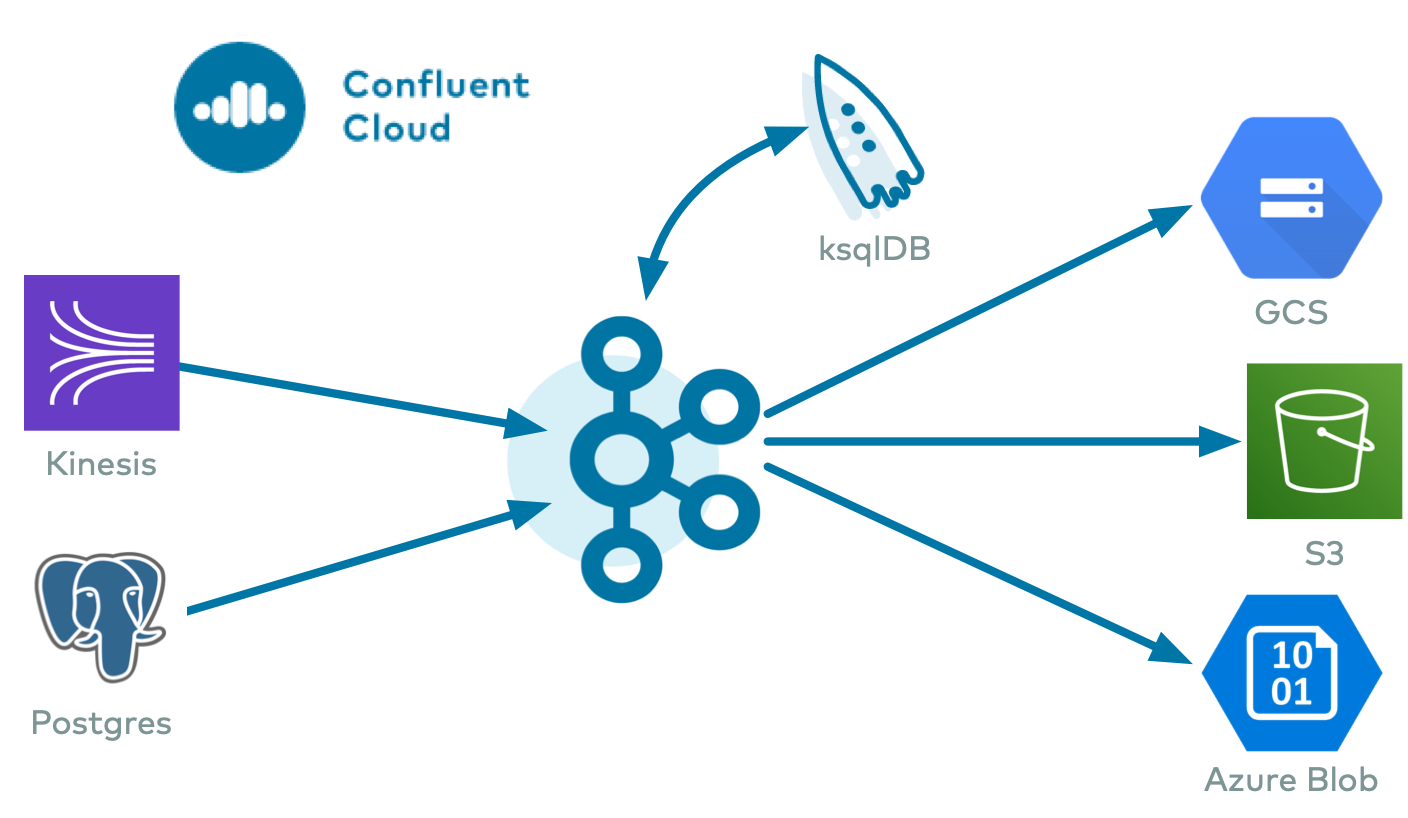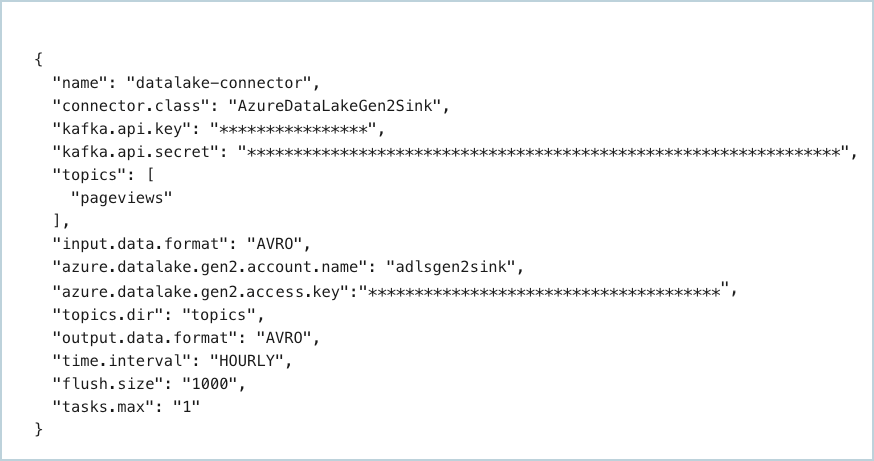Azure Data Lake Storage Gen2 Sink Connector for Confluent Cloud
You can use the fully-managed Azure Data Lake Storage Gen2 Sink connector for Confluent Cloud to export Avro, JSON Schema, Protobuf, JSON (schemaless), or Bytes data from Apache Kafka® topics to Azure storage in Avro, Parquet, JSON, or Bytes format. Depending on your configuration, the Azure Data Lake Storage Gen2 (ADLS Gen2) Sink connector can export data by guaranteeing exactly-once delivery semantics to consumers of the Azure Data Lake Storage Gen2 files it produces.
The ADLS Gen2 Sink connector periodically polls data from Kafka and, in turn, uploads it to Azure Data Lake storage. A partitioner is used to split the data of every Kafka partition into chunks. Each chunk of data is represented as an Azure Data Lake Storage Gen2 file. The key name encodes the topic, the Kafka partition, and the start offset of this data chunk. The size of each data chunk is determined by the number of records written to Azure Data Lake storage and by schema compatibility.
Confluent Cloud is available through Azure Marketplace or directly from Confluent.
Note
This Quick Start is for the fully-managed Confluent Cloud connector. If you are installing the connector locally for Confluent Platform, see Azure Data Lake Storage Gen2 Sink connector for Confluent Platform.
If you require private networking for fully-managed connectors, make sure to set up the proper networking beforehand. For more information, see Manage Networking for Confluent Cloud Connectors.
Features
The Azure Data Lake Storage Gen2 (ADLS Gen2) Sink connector provides the following features:
Write once, read many (WORM) support: The connector supports WORM-enabled Azure Data Lake Storage Gen2 containers. Since data cannot be modified or deleted once written, the connector only supports at-least-once delivery semantics. As a prerequisite, the immutability policies must enable the
AllowProtectedAppendWritesAllproperty. For more information, see Allow protected writes.Provider integration support: The connector supports Microsoft’s native identity authorization using Confluent Provider Integration. For more information about provider integration setup, see the connector authentication.
Client-side encryption (CSFLE and CSPE) support: The connector supports CSFLE and CSPE for sensitive data. For more information about CSFLE or CSPE setup, see the connector configuration.
Exactly Once Delivery: Records that are exported using a deterministic partitioner are delivered with exactly-once semantics regardless of the eventual consistency of Azure Data Lake storage, provided that the WORM is not enabled on the container.
Data formats with or without a schema: The connector supports Avro, JSON Schema, Protobuf, or JSON (schemaless) input data formats and Avro, Parquet, JSON, and Bytes output formats. Schema Registry must be enabled to use a Schema Registry-based format (for example, Avro, JSON Schema, or Protobuf). See Schema Registry Enabled Environments for additional information.
Schema Evolution:
schema.compatibilityis set toNONE.Scheduled Rotation and Rotation Interval: The connector supports a regularly scheduled interval for closing and uploading files to storage. See Scheduled Rotation for details.
Partitioner: The connector supports two classes for partitioning data:
Time-Based Partitioner: The connector supports theTimeBasedPartitionerclass based on the Kafka classTimeStamp. Time-based partitioning options are daily or hourly.Default Partitioner: The connector supports theDefaultPartitionerclass, which writes all records to files within a single directory, without time-based separation.
Flush size: Defaults to 1000. The value can be increased if needed. The value can be lowered (1 minimum) if you are running a Dedicated Confluent Cloud cluster. The minimum value is 1000 for non-dedicated clusters.
The following scenarios describe a couple of ways records may be flushed to storage:
You use the default setting of 1000 and your topic has six partitions. Files start to be created in storage after more than 1000 records exist in each partition.
You use the default setting of 1000 and the partitioner is set to Hourly. 500 records arrive at one partition from 2:00pm to 3:00pm. At 3:00pm, an additional 5 records arrive at the partition. You will see 500 records in storage at 3:00pm.
Note
The properties
rotate.schedule.interval.msandrotate.interval.mscan be used withflush.sizeto determine when files are created in storage. These parameters kick in and files are stored based on which condition is met first.For FieldPartitioner in fully-managed connectors, an additional automatic rotation occurs when the number of open files reaches 50. This uploads the current batch of files to storage and creates a new batch.
For example: You have one topic partition. You set
flush.size=1000androtate.schedule.interval.ms=600000(10 minutes). 500 records arrive at the topic partition from 12:01 to 12:10. 500 additional records arrive from 12:11 to 12:20. You will see two files in the storage bucket with 500 records in each file. This is because the 10 minuterotate.schedule.interval.mscondition tripped before theflush.size=1000condition was met.
For more information and examples to use with the Confluent Cloud API for Connect, see the Confluent Cloud API for Connect Usage Examples section.
Limitations
Be sure to review the following information.
For connector limitations, see Azure Data Lake Storage Gen2 Sink Connector limitations.
If you plan to use one or more Single Message Transforms (SMTs), see SMT Limitations.
If you plan to use Confluent Cloud Schema Registry, see Schema Registry Enabled Environments.
Azure Storage Authentication
The following provides basic information about setting up connector access to Azure storage. Before continuing, you should be familiar with accessing blobs using Azure Active Directory.
There are two ways to set up authentication for your connector to access Azure: Basic authentication or Active Directory authentication.
Basic authentication
The highlighted properties are required for basic authentication. Basic authentication is typically used to test the connector in development. You provide a storage account name and the storage access key.
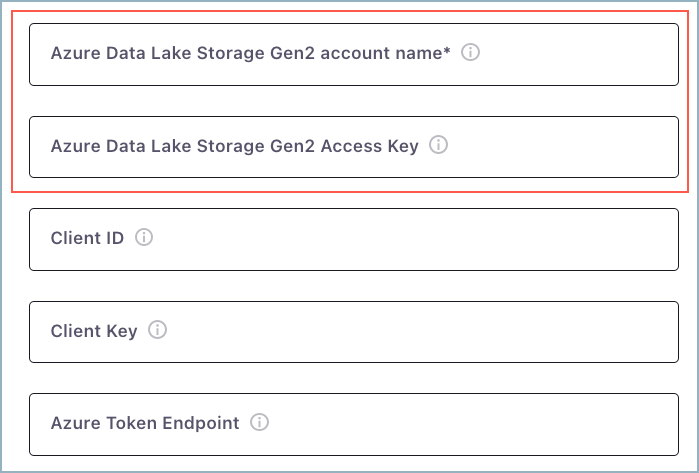
Active Directory authentication
The highlighted properties are required for authentication with Active Directory (AD).
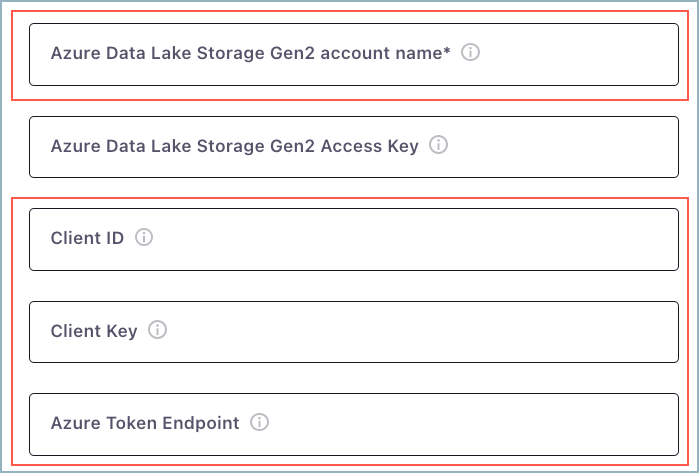
When authenticating with AD, you first need to establish the relationship between the connector and the Microsoft identity platform. You do this by registering the connector as a trusted application. Once you have registered the application, you can get or create the following items from the Azure portal or using the Azure CLI:
Client ID: In Azure, this is the Application (client) ID created when registering the application. It is displayed in the Azure portal or you can get it using the Azure CLI.

Client Key: In Azure, this is the Client secret you create after registering the AD application. The example below shows what this looks like in the Azure portal.

Azure Token Endpoint: The OAuth 2.0 token endpoint is created automatically when you register the application with AD. You can find these in the dashboard for the AD application. Copy and paste the OAuth 2.0 token endpoint (v1) into the property.
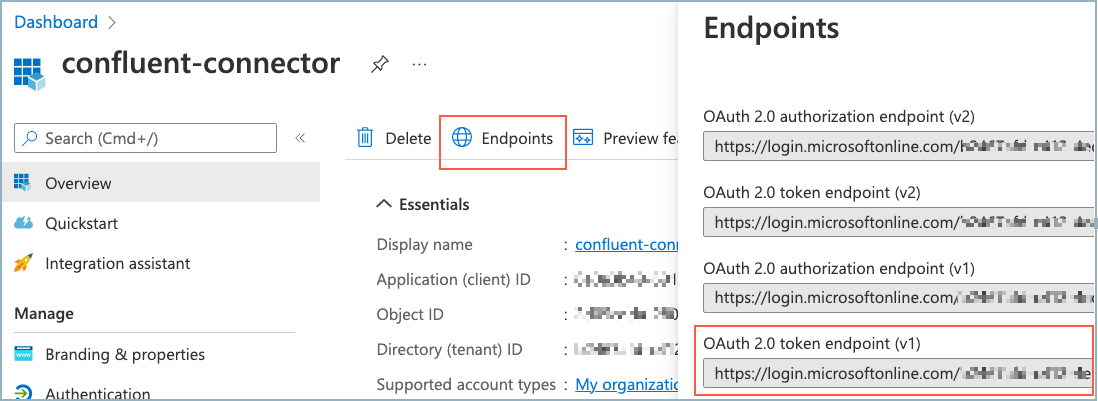
Minimum role permission
You must create a role assignment for the connector to be able to access Azure Data Lake storage. Minimally, the connector requires the role Storage BlobData Contributor. For information about assigning this role to the AD application, see Assign roles.
Azure CLI commands
The following are a few example commands to use when setting up authentication for the connector. Be sure to use the latest version of the Azure CLI.
To create the AD application for the connector:
az ad app create --display-name <Connector-AD-Application-Name> \
--is-fallback-public-client false --sign-in-audience AzureADandPersonalMicrosoftAccount --query appId -o tsv
To create a service principal:
az ad sp create --id <AD-Application-Client-ID>
To assign the role Storage Blob Data Contributor to the service principal:
az role assignment create --assignee <Service-Principal-ID> \
--role "Storage Blob Data Contributor"
Quick Start
Use this quick start to get up and running with the ADLS Gen2 Sink connector. The quick start provides the basics of selecting the connector and configuring it to stream events to Azure storage.
- Prerequisites
Authorized access to a Confluent Cloud cluster on Microsoft Azure.
The Confluent CLI installed and configured for the cluster. See Install the Confluent CLI.
Schema Registry must be enabled to use a Schema Registry-based format (for example, Avro, JSON_SR (JSON Schema), or Protobuf). See Schema Registry Enabled Environments for additional information.
Azure Data Lake storage should be in the same region as your Confluent Cloud cluster. If you use a different region, be aware that you may incur additional data transfer charges. Contact Confluent Support if you need to use Confluent Cloud and Azure Data Lake storage in different regions.
Authentication configured for Azure storage. For details, see Azure Storage Authentication.
Kafka cluster credentials. The following lists the different ways you can provide credentials.
Enter an existing service account resource ID.
Create a Confluent Cloud service account for the connector. Make sure to review the ACL entries required in the service account documentation. Some connectors have specific ACL requirements.
Create a Confluent Cloud API key and secret. To create a key and secret, you can use confluent api-key create or you can autogenerate the API key and secret directly in the Cloud Console when setting up the connector.
Caution
You can’t mix schema and schemaless records in storage using kafka-connect-storage-common. Attempting this causes a runtime exception.
Using the Confluent Cloud Console
Step 1: Launch your Confluent Cloud cluster
To create and launch a Kafka cluster in Confluent Cloud, see Create a kafka cluster in Confluent Cloud.
Step 2: Add a connector
In the left navigation menu, click Connectors. If you already have connectors in your cluster, click + Add connector.
Step 3: Select your connector
Click the Azure Data Lake Storage Gen2 Sink connector card.
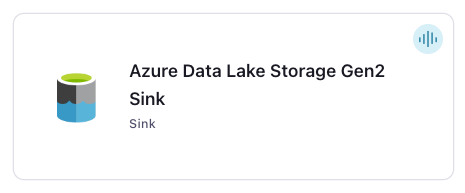
Step 4: Enter the connector details
Note
Ensure you have all your prerequisites completed.
An asterisk ( * ) designates a required entry.
At the Add Azure Data Lake Storage Gen2 Sink Connector screen, complete the following:
If you’ve already populated your Kafka topics, select the topics you want to connect from the Topics list.
To create a new topic, click +Add new topic.
Select the way you want to provide Kafka Cluster credentials. You can choose one of the following options:
My account: This setting allows your connector to globally access everything that you have access to. With a user account, the connector uses an API key and secret to access the Kafka cluster. This option is not recommended for production.
Service account: This setting limits the access for your connector by using a service account. This option is recommended for production.
Use an existing API key: This setting allows you to specify an API key and a secret pair. You can use an existing pair or create a new one. This method is not recommended for production environments.
Note
Freight clusters support only service accounts for Kafka authentication.
Click Continue.
Configure the authentication properties:
Azure credentials
Authentication method: Under Azure credentials, select how you want to authenticate with the database:
If you select Storage Account Key, enter the following Azure Data Lake storage details:
Azure Data Lake Storage Gen2 Access Key: The access key for the storage account.
If you select Microsoft Entra ID application, enter the following Azure details:
Under the Provider integration dropdown, select an existing integration name that has access to your Azure resource required to run this connector. For more information, see Manage an Microsoft Azure Provider Integration.
If you select OAuth Client Credential, enter the following Azure Data Lake storage details:
Client ID: The client ID (GUID) of the client obtained from Azure Active Directory configuration.
Client Key: The secret key of the client.
Azure Token Endpoint: The OAuth 2.0 token endpoint associated with the user’s directory (obtain from Active Directory configuration).
For more information, see Azure Storage Authentication.
Provider Integration: Select an existing integration name that has access to your Azure resource required to run this connector. Required for
Microsoft Entra IDauthentication.Azure Data Lake Storage Gen2 Access Key: Access Key for the storage account. Required for
Storage Account Keyauthentication.Client ID: The client ID (GUID) of the client obtained from Azure Active Directory configuration. Required for
OAuth Client Credentialauthentication.Client Key: The secret key of the client. Required for
OAuth Client Credentialauthentication.Azure Token Endpoint: The OAuth 2.0 token endpoint associated with the user’s directory (obtain from Active Directory configuration). Required for
OAuth Client Credentialauthentication.
How should we connect to your ADLS Gen2 storage account?
Azure Data Lake Storage Gen2 account name: The account name for the storage account. Must be between 3-23 alphanumeric characters.
Click Continue.
Note
Configuration properties that are not shown in the Cloud Console use the default values. See Azure Data Lake Storage Gen2 Sink Connector Configuration Properties for default values and property definitions.
Input Kafka record value format: Select an input Kafka record value format (data coming from the Kafka topic). Valid entries are
AVRO,JSON_SR(JSON Schema),PROTOBUF,JSON(schemaless), orBYTES. A valid schema must be available in Schema Registry to use a schema-based message format (for example, AVRO, JSON_SR, or PROTOBUF). See Schema Registry Enabled Environments for additional information.Note
Input format JSON to output format AVRO does not work for the connector.
Output message format: Select the output message format (data coming from the connector). Valid entries are
AVRO,PARQUET,JSON, orBYTES. A valid schema must be available in Schema Registry to use a schema-based message format (for example,AVRO). For more information, see Schema Registry Enabled Environments.Partitioner Class: The partitioner to use when writing data to the Azure Data Lake Storage container. Supported values are
DefaultPartitioner(organizes records by the topic partition) andTimeBasedPartitioner(organizes records by time, e.g., daily or hourly).Flush size: Enter the Flush size. This value defaults to 1000. The default value can be raised (and lowered, if running a dedicated cluster).
Path format: This configuration is used to set the format of the data directories when partitioning with TimeBasedPartitioner. The format set in this configuration converts the Unix timestamp to a valid directory string. To organize files like this example, https://<storage-account-name>.blob.core.windows.net/<container-name>/json_logs/daily/<Topic-Name>/dt=2020-02-06/hr=09/<files>, use the properties: topics.dir=json_logs/daily, path.format=’dt’=YYYY-MM-dd/’hr’=HH, and time.interval=HOURLY.
Locale: Sets the locale to use with TimeBasedPartitioner.
Timezone: Sets the timezone used by the TimeBasedPartitioner.
Timestamp field name: Sets the field that contains the timestamp used for the TimeBasedPartitioner
Time interval: Enter the Time interval that sets how you want your messages grouped in the bucket. For example, if you select
HOURLY, messages are grouped into folders for each hour data is streamed to the bucket.
Data decryption
(Optional) Enable Client-Side Field Level Encryption for data decryption. Specify a Service Account to access the Schema Registry and associated encryption rules or keys with that schema. Select the connector behavior (
ERRORorNONE) on data decryption failure. If set toERROR, the connector fails and writes the encrypted data in the DLQ. If set toNONE, the connector writes the encrypted data in the target system without decryption. For more information on CSFLE or CSPE setup, see Manage encryption for connectors.
Show advanced configurations
Schema context: Select a schema context to use for this connector, if using a schema-based data format. This property defaults to the Default context, which configures the connector to use the default schema set up for Schema Registry in your Confluent Cloud environment. A schema context allows you to use separate schemas (like schema sub-registries) tied to topics in different Kafka clusters that share the same Schema Registry environment. For example, if you select a non-default context, a Source connector uses only that schema context to register a schema and a Sink connector uses only that schema context to read from. For more information about setting up a schema context, see What are schema contexts and when should you use them?.
Parquet Compression Codec: Compression type for parquet files written to Azure. You can select either
none,gzip, orsnappy.Maximum span of record time (in ms) before scheduled rotation: Scheduled rotation uses
rotate.schedule.interval.msto close the file and upload to storage on regular basis using the current time, rather than the record time. Settingrotate.schedule.interval.msis nondeterministic and will invalidate exactly once guarantees. Minimum value is 60000 ms (10 minutes).Topic directory: Top-level directory where ingested data is stored.
Maximum span of record time (in ms) before rotation: Specify the maximum time span (in milliseconds) that a file can remain open for additional records. When using
rotate.interval.ms, the time span interval for the file starts with the timestamp of the first record added to the file. The connector closes and uploads the file to storage when the timestamp of a subsequent record falls outside the time span set by the first file’s timestamp. The minimum value is 600000 ms (10 minutes). See Scheduled Rotation for details about Scheduled rotation properties.
Additional Configs
Value Converter Replace Null With Default: Whether to replace fields that have a default value and that are null to the default value. When set to true, the default value is used, otherwise null is used. Applicable for JSON Converter.
Value Converter Reference Subject Name Strategy: Set the subject reference name strategy for value. Valid entries are DefaultReferenceSubjectNameStrategy or QualifiedReferenceSubjectNameStrategy. Note that the subject reference name strategy can be selected only for PROTOBUF format with the default strategy being DefaultReferenceSubjectNameStrategy.
Value Converter Schemas Enable: Include schemas within each of the serialized values. Input messages must contain schema and payload fields and may not contain additional fields. For plain JSON data, set this to false. Applicable for JSON Converter.
Errors Tolerance: Use this property if you would like to configure the connector’s error handling behavior. WARNING: This property should be used with CAUTION for SOURCE CONNECTORS as it may lead to dataloss. If you set this property to ‘all’, the connector will not fail on errant records, but will instead log them (and send to DLQ for Sink Connectors) and continue processing. If you set this property to ‘none’, the connector task will fail on errant records.
Value Converter Ignore Default For Nullables: When set to true, this property ensures that the corresponding record in Kafka is NULL, instead of showing the default column value. Applicable for AVRO,PROTOBUF and JSON_SR Converters.
Value Converter Decimal Format: Specify the JSON/JSON_SR serialization format for Connect DECIMAL logical type values with two allowed literals: BASE64 to serialize DECIMAL logical types as base64 encoded binary data and NUMERIC to serialize Connect DECIMAL logical type values in JSON/JSON_SR as a number representing the decimal value.
Value Converter Connect Meta Data: Allow the Connect converter to add its metadata to the output schema. Applicable for Avro Converters.
Value Converter Value Subject Name Strategy: Determines how to construct the subject name under which the value schema is registered with Schema Registry.
Key Converter Key Subject Name Strategy: How to construct the subject name for key schema registration.
Auto-restart policy
Enable Connector Auto-restart: Control the auto-restart behavior of the connector and its task in the event of user-actionable errors. Defaults to
true, enabling the connector to automatically restart in case of user-actionable errors. Set this property tofalseto disable auto-restart for failed connectors. In such cases, you would need to manually restart the connector.
Consumer configuration
Max poll interval(ms): Set the maximum delay between subsequent consume requests to Kafka. Use this property to improve connector performance in cases when the connector cannot send records to the sink system. The default is 300,000 milliseconds (5 minutes).
Max poll records: Set the maximum number of records to consume from Kafka in a single request. Use this property to improve connector performance in cases when the connector cannot send records to the sink system. The default is 500 records.
Transforms
Single Message Transforms: To add a new SMT, see Add transforms. For more information about unsupported SMTs, see Unsupported transformations.
Processing position
Set offsets: Click Set offsets to define a specific offset for this connector to begin procession data from. For more information on managing offsets, see Manage offsets.
Click Continue.
Based on the number of topic partitions you select, you will be provided with a recommended number of tasks.
To change the number of recommended tasks, enter the number of tasks for the connector to use in the Tasks field.
Click Continue.
Step 5: Check the Azure storage container
From the Azure portal, go to your Azure storage account.
Open each folder until you see your messages displayed.
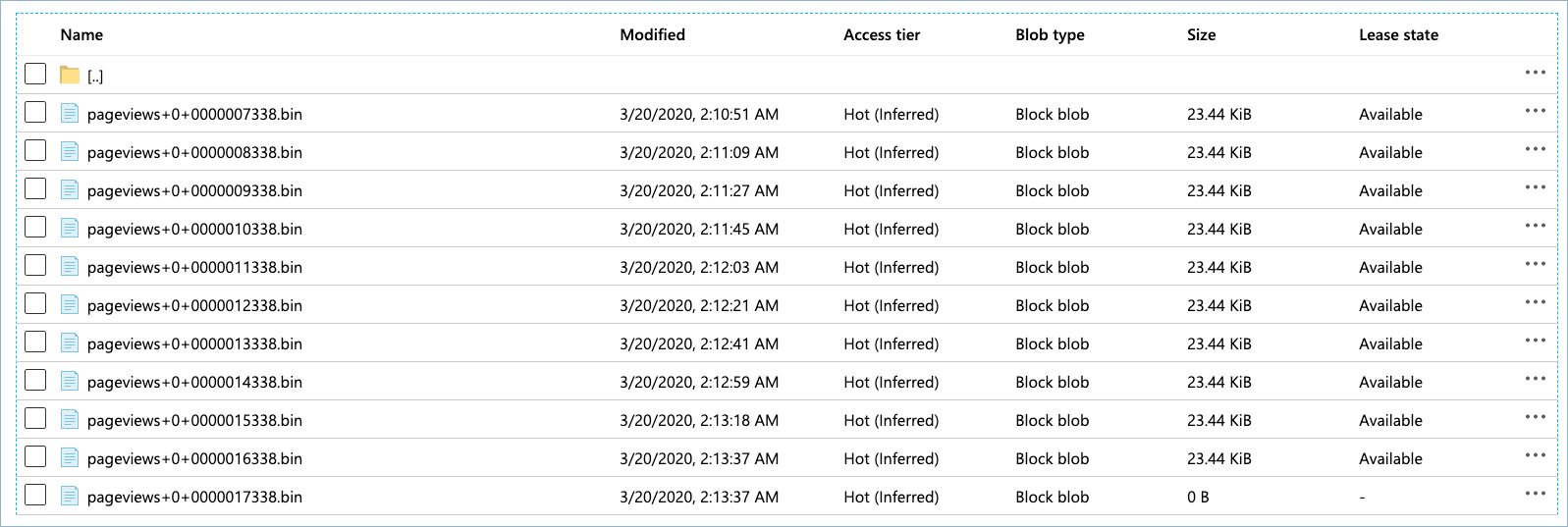
For more information and examples to use with the Confluent Cloud API for Connect, see the Confluent Cloud API for Connect Usage Examples section.
Tip
When you launch a connector, a Dead Letter Queue topic is automatically created. See View Connector Dead Letter Queue Errors in Confluent Cloud for details.
Using the Confluent CLI
Complete the following steps to set up and run the connector using the Confluent CLI.
Note
Make sure you have all your prerequisites completed.
Step 1: List the available connectors
Enter the following command to list available connectors:
confluent connect plugin list
Step 2: List the connector configuration properties
Enter the following command to show the connector configuration properties:
confluent connect plugin describe <connector-plugin-name>
The command output shows the required and optional configuration properties.
Step 3: Create the connector configuration file
Create a JSON file that contains the connector configuration properties. The following examples show the required connector properties for both partitioner types.
Example configuration for TimeBasedPartitioner:
{
"name": "adls-sink-connector",
"connector.class": "AzureDataLakeGen2Sink",
"kafka.auth.mode": "KAFKA_API_KEY",
"kafka.api.key": "<my-kafka-api-key>",
"kafka.api.secret": "<my-kafka-api-secret>",
"topics": "pageviews",
"input.data.format": "AVRO",
"azure.datalake.gen2.account.name": "<account-name>",
"azure.datalake.gen2.access.key": "<access-key>",
"topics.dir": "topics",
"output.data.format": "AVRO",
"partitioner.class": "TimeBasedPartitioner",
"time.interval": "HOURLY",
"flush.size": "1000",
"tasks.max": "1"
}
Example configuration for DefaultPartitioner:
{
"name": "adls-sink-connector",
"connector.class": "AzureDataLakeGen2Sink",
"kafka.auth.mode": "KAFKA_API_KEY",
"kafka.api.key": "<my-kafka-api-key>",
"kafka.api.secret": "<my-kafka-api-secret>",
"topics": "pageviews",
"input.data.format": "AVRO",
"azure.datalake.gen2.account.name": "<account-name>",
"azure.datalake.gen2.access.key": "<access-key>",
"topics.dir": "topics",
"output.data.format": "AVRO",
"partitioner.class": "DefaultPartitioner",
"flush.size": "1000",
"tasks.max": "1"
}
Note the following property definitions:
"name": Sets a name for your new connector."connector.class": Identifies the connector plugin name.
"kafka.auth.mode": Identifies the connector authentication mode you want to use. There are two options:SERVICE_ACCOUNTorKAFKA_API_KEY(the default). To use an API key and secret, specify the configuration propertieskafka.api.keyandkafka.api.secret, as shown in the example configuration (above). To use a service account, specify the Resource ID in the propertykafka.service.account.id=<service-account-resource-ID>. To list the available service account resource IDs, use the following command:confluent iam service-account list
For example:
confluent iam service-account list Id | Resource ID | Name | Description +---------+-------------+-------------------+------------------- 123456 | sa-l1r23m | sa-1 | Service account 1 789101 | sa-l4d56p | sa-2 | Service account 2
The configuration example above shows basic Azure authentication properties. For Active Directory (AD) authentication details, see Azure Storage Authentication. For the configuration properties to use, see Configuration Properties.
"topics": Identifies the topic name or a comma-separated list of topic names."input.data.format": Sets the input Kafka record value format. Valid entries are AVRO, JSON_SR, PROTOBUF, JSON, or BYTES. You must have Confluent Cloud Schema Registry configured if using a schema-based message format (for example, Avro, JSON_SR (JSON Schema), or Protobuf).Note
Input format JSON to output format AVRO does not work for the connector.
"topics.dir": The example above shows the default entrytopics. In this example, the directory hierarchy created istopics/pageviews. Each Kafka topic will have a separate subdirectory based on the Kafka topic name.topics.dirshouldn’t start with/."output.data.format": Sets the output Kafka record value format (data coming from the connector). Valid entries are AVRO, PARQUET, JSON, or BYTES. You must have Confluent Cloud Schema Registry configured if using a schema-based output format (for example, Avro). For more information, see Schema Registry Enabled Environments."partitioner.class": Sets the partitioner class to use. Valid entries are:"TimeBasedPartitioner"(default)"DefaultPartitioner"
(Optional)
flush.size: Defaults to 1000. The value can be increased if needed. The value can be lowered (1 minimum) if you are running a Dedicated Confluent Cloud cluster. The minimum value is 1000 for non-dedicated clusters.The following scenarios describe a couple of ways records may be flushed to storage:
You use the default setting of 1000 and your topic has six partitions. Files start to be created in storage after more than 1000 records exist in each partition.
You use the default setting of 1000 and the partitioner is set to Hourly. 500 records arrive at one partition from 2:00pm to 3:00pm. At 3:00pm, an additional 5 records arrive at the partition. You will see 500 records in storage at 3:00pm.
Note
The properties
rotate.schedule.interval.msandrotate.interval.mscan be used withflush.sizeto determine when files are created in storage. These parameters kick in and files are stored based on which condition is met first.For FieldPartitioner in fully-managed connectors, an additional automatic rotation occurs when the number of open files reaches 50. This uploads the current batch of files to storage and creates a new batch.
For example: You have one topic partition. You set
flush.size=1000androtate.schedule.interval.ms=600000(10 minutes). 500 records arrive at the topic partition from 12:01 to 12:10. 500 additional records arrive from 12:11 to 12:20. You will see two files in the storage bucket with 500 records in each file. This is because the 10 minuterotate.schedule.interval.mscondition tripped before theflush.size=1000condition was met.
"time.interval":(TimeBasedPartitioner only) Sets how your messages are grouped in the GCS bucket. Valid entries are DAILY or HOURLY.
Tip
The time.interval property above and the following optional properties topics.dir and path.format can be used to build a directory structure for stored data. For example: You set "time.interval" : "HOURLY", "topics.dir" : "json_logs/hourly", and "path.format" :"'dt'=YYYY-MM-dd/'hr'=HH". The result is the directory structure: //bucket-name>/json_logs/daily/<Topic-Name>/dt=2020-02-06/hr=09/<files>.
"topics.dir": A top-level directory path to use for stored data. Defaults totopicsif not used."path.format":(TimeBasedPartitioner only) Configures the time-based partitioning path created. The property converts the UNIX timestamp to a date format string. If not used, this property defaults to'year'=YYYY/'month'=MM/'day'=dd/'hour'=HHif an Hourlytime.intervalwas selected or'year'=YYYY/'month'=MM/'day'=ddif a Daily Time interval was selected.rotate.schedule.interval.msandrotate.interval.ms: See Scheduled Rotation for details about using these properties."tasks.max": Enter the maximum number of connector tasks to use.
Note
(Optional) To enable CSFLE or CSPE for data encryption, specify the following properties:
csfle.enabled: Flag to indicate whether the connector honors CSFLE or CSPE rules.sr.service.account.id: A Service Account to access the Schema Registry and associated encryption rules or keys with that schema.csfle.onFailure: Configures the connector behavior (ERRORorNONE) on data decryption failure. If set toERROR, the connector fails and writes the encrypted data in the DLQ. If set toNONE, the connector writes the encrypted data in the target system without decryption.
When using CSFLE or CSPE with connectors that route failed messages to a Dead Letter Queue (DLQ), be aware that data sent to the DLQ is written in plaintext (unencrypted). This poses a significant security risk as sensitive data that should be encrypted may be exposed in the DLQ.
Do not use DLQ with CSFLE or CSPE in the current version. If you need error handling for CSFLE- or CSPE-enabled data, use alternative approaches such as:
Setting the connector behavior to
ERRORto throw exceptions instead of routing to DLQImplementing custom error handling in your applications
Using
NONEto pass encrypted data through without decryption
For more information on CSFLE or CSPE setup, see Manage encryption for connectors.
Single Message Transforms: See the Single Message Transforms (SMT) documentation for details about adding SMTs using the CLI. See Unsupported transformations for a list of SMTs that are not supported with this connector.
See Configuration Properties for all property values and definitions.
Step 4: Load the properties file and create the connector
Enter the following command to load the configuration and start the connector:
confluent connect cluster create --config-file <file-name>.json
For example:
confluent connect cluster create --config-file adls-sink-config.json
Example output:
Created connector adls-sink-connector lcc-ix4dl
Step 5: Check the connector status
Enter the following command to check the connector status:
confluent connect cluster list
Example output:
ID | Name | Status | Type
+-----------+---------------------------+---------+------+
lcc-ix4dl | adls-sink-connector | RUNNING | sink
Step 6: Check the Azure storage container.
From the Azure portal, go to your Azure storage account.
Open each folder until you see your messages displayed.

For more information and examples to use with the Confluent Cloud API for Connect, see the Confluent Cloud API for Connect Usage Examples section.
Tip
When you launch a connector, a Dead Letter Queue topic is automatically created. See View Connector Dead Letter Queue Errors in Confluent Cloud for details.
Scheduled Rotation
Two optional properties are available that allow you to set up a rotation schedule. These properties are provided in the Cloud Console (shown below) and in the Confluent CLI.
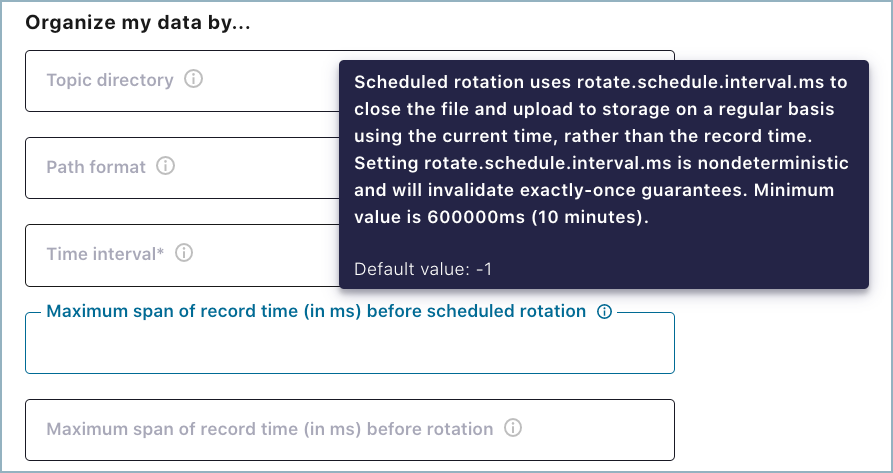
rotate.schedule.interval.ms(Scheduled rotation): This property allows you to configure a regular schedule for when files are closed and uploaded to storage. The default value is-1(disabled). For example, when this is set for 600000 ms, you will see files available in the storage bucket at least every 10 minutes.rotate.schedule.interval.msdoes not require a continuous stream of data.Note
Using the
rotate.schedule.interval.msproperty results in a non-deterministic environment and invalidates exactly-once guarantees.rotate.interval.ms(Rotation interval): This property allows you to specify the maximum time span (in milliseconds) that a file can remain open for additional records. When using this property, the time span interval for the file starts with the timestamp of the first record added to the file. The connector closes and uploads the file to storage when the timestamp of a subsequent record falls outside the time span set by the first file’s timestamp. This property defaults to the interval set by thetime.intervalproperty.rotate.interval.msrequires a continuous stream of data.Important
The start and end of the time span interval is determined using file timestamps. For this reason, a file could potentially remain open for a long time if a record does not arrive with a timestamp falling outside the time span set by the first file’s timestamp.
Configuration Properties
Use the following configuration properties with the fully-managed connector. For self-managed connector property definitions and other details, see the connector docs in Self-managed connectors for Confluent Platform.
Which topics do you want to get data from?
topics.regexA regular expression that matches the names of the topics to consume from. This is useful when you want to consume from multiple topics that match a certain pattern without having to list them all individually.
Type: string
Importance: low
topicsIdentifies the topic name or a comma-separated list of topic names.
Type: list
Importance: high
errors.deadletterqueue.topic.nameThe name of the topic to be used as the dead letter queue (DLQ) for messages that result in an error when processed by this sink connector, or its transformations or converters. Defaults to ‘dlq-${connector}’ if not set. The DLQ topic will be created automatically if it does not exist. You can provide
${connector}in the value to use it as a placeholder for the logical cluster ID.Type: string
Default: dlq-${connector}
Importance: low
Schema Config
schema.context.nameAdd a schema context name. A schema context represents an independent scope in Schema Registry. It is a separate sub-schema tied to topics in different Kafka clusters that share the same Schema Registry instance. If not used, the connector uses the default schema configured for Schema Registry in your Confluent Cloud environment.
Type: string
Default: default
Importance: medium
Input messages
input.data.formatSets the input message format. Valid entries are AVRO, JSON_SR, PROTOBUF, JSON or BYTES. Note that you need to have Confluent Cloud Schema Registry configured if using a schema-based message format like AVRO, JSON_SR, and PROTOBUF
Type: string
Default: JSON
Importance: high
How should we connect to your data?
nameSets a name for your connector.
Type: string
Valid Values: A string at most 64 characters long
Importance: high
Azure credentials
provider.integration.idAzure provider-integration to mint Microsoft Entra ID application tokens.
Type: string
Importance: high
authentication.methodHow Confluent Cloud authenticates with Azure.
Type: string
Default: “”
Importance: high
azure.datalake.gen2.access.keyAccess Key for the storage account.
Type: password
Importance: high
azure.datalake.gen2.client.idThe client ID (GUID) of the client obtained from Azure Active Directory configuration.
Type: string
Importance: high
azure.datalake.gen2.client.keyThe secret key of the client.
Type: password
Importance: high
azure.datalake.gen2.token.endpointThe OAuth 2.0 token endpoint associated with the user’s directory (obtain from Active Directory configuration)
Type: string
Importance: high
How should we connect to your ADLS Gen2 storage account?
azure.datalake.gen2.account.nameMust be between 3-23 alphanumeric characters.
Type: string
Importance: high
Kafka Cluster credentials
kafka.auth.modeKafka Authentication mode. It can be one of KAFKA_API_KEY or SERVICE_ACCOUNT. It defaults to KAFKA_API_KEY mode, whenever possible.
Type: string
Valid Values: SERVICE_ACCOUNT, KAFKA_API_KEY
Importance: high
kafka.api.keyKafka API Key. Required when kafka.auth.mode==KAFKA_API_KEY.
Type: password
Importance: high
kafka.service.account.idThe Service Account that will be used to generate the API keys to communicate with Kafka Cluster.
Type: string
Importance: high
kafka.api.secretSecret associated with Kafka API key. Required when kafka.auth.mode==KAFKA_API_KEY.
Type: password
Importance: high
Destination
topics.dirTop-level directory where ingested data is stored. The topics.dir entry should not start with /.
Type: string
Default: topics
Importance: high
Output messages
output.data.formatSet the output message format for values. Valid entries are AVRO, JSON, PARQUET or BYTES. Note that you need to have Confluent Cloud Schema Registry configured if using a schema-based message format like AVRO. Note that the output message format defaults to the value in the Input Message Format field. If either PROTOBUF or JSON_SR is selected as the input message format, you should select one explicitly. If no value for this property is provided, the value specified for the ‘input.data.format’ property is used.
Type: string
Importance: high
parquet.codecCompression type for parquet files written to Azure.
Type: string
Importance: high
Organize my data by…
partitioner.classThe partitioner to use when writing data to the Azure Data Lake Storage container. Supported values are DefaultPartitioner (organizes records by the topic partition) and TimeBasedPartitioner (organizes records by time, e.g., daily or hourly).
Type: string
Default: TimeBasedPartitioner
Valid Values: DefaultPartitioner, TimeBasedPartitioner
Importance: high
path.formatThis configuration is used to set the format of the data directories when partitioning with TimeBasedPartitioner. The format set in this configuration converts the Unix timestamp to a valid directory string. To organize files like this example, https://<storage-account-name>.blob.core.windows.net/<container-name>/json_logs/daily/<Topic-Name>/dt=2020-02-06/hr=09/<files>, use the properties: topics.dir=json_logs/daily, path.format=’dt’=YYYY-MM-dd/’hr’=HH, and time.interval=HOURLY.
Type: string
Default: ‘year’=YYYY/’month’=MM/’day’=dd/’hour’=HH
Importance: high
localeSets the locale to use with TimeBasedPartitioner.
Type: string
Default: en
Importance: high
timezoneSets the timezone used by the TimeBasedPartitioner.
Type: string
Default: UTC
Importance: high
rotate.schedule.interval.msScheduled rotation uses rotate.schedule.interval.ms to close the file and upload to storage on a regular basis using the current time, rather than the record time. Setting rotate.schedule.interval.ms is nondeterministic and will invalidate exactly-once guarantees.
Type: int
Default: -1
Importance: medium
rotate.interval.msThe connector’s rotation interval specifies the maximum timespan (in milliseconds) a file can remain open and ready for additional records. In other words, when using rotate.interval.ms, the timestamp for each file starts with the timestamp of the first record inserted in the file. The connector closes and uploads a file to the blob store when the next record’s timestamp does not fit into the file’s rotate.interval time span from the first record’s timestamp. If the connector has no more records to process, the connector may keep the file open until the connector can process another record (which can be a long time). If no value for this property is provided, the value specified for the ‘time.interval’ property is used.
Type: int
Importance: high
timestamp.fieldSets the field that contains the timestamp used for the TimeBasedPartitioner
Type: string
Default: “”
Importance: high
time.intervalPartitioning interval of data, according to the time ingested to storage.
Type: string
Valid Values: DAILY, HOURLY
Importance: high
flush.sizeNumber of records written to storage before invoking file commits.
Type: int
Default: 1000
Valid Values: [1000,…] for non-dedicated clusters and [1,…] for dedicated clusters
Importance: high
Consumer configuration
max.poll.interval.msThe maximum delay between subsequent consume requests to Kafka. This configuration property may be used to improve the performance of the connector, if the connector cannot send records to the sink system. Defaults to 300000 milliseconds (5 minutes).
Type: long
Default: 300000 (5 minutes)
Valid Values: [60000,…,1800000] for non-dedicated clusters and [60000,…] for dedicated clusters
Importance: low
max.poll.recordsThe maximum number of records to consume from Kafka in a single request. This configuration property may be used to improve the performance of the connector, if the connector cannot send records to the sink system. Defaults to 500 records.
Type: long
Default: 500
Valid Values: [1,…,500] for non-dedicated clusters and [1,…] for dedicated clusters
Importance: low
Number of tasks for this connector
tasks.maxMaximum number of tasks for the connector.
Type: int
Valid Values: [1,…]
Importance: high
Additional Configs
consumer.override.auto.offset.resetDefines the behavior of the consumer when there is no committed position (which occurs when the group is first initialized) or when an offset is out of range. You can choose either to reset the position to the “earliest” offset (the default) or the “latest” offset. You can also select “none” if you would rather set the initial offset yourself and you are willing to handle out of range errors manually. More details: https://docs.confluent.io/platform/current/installation/configuration/consumer-configs.html#auto-offset-reset
Type: string
Importance: low
consumer.override.isolation.levelControls how to read messages written transactionally. If set to read_committed, consumer.poll() will only return transactional messages which have been committed. If set to read_uncommitted (the default), consumer.poll() will return all messages, even transactional messages which have been aborted. Non-transactional messages will be returned unconditionally in either mode. More details: https://docs.confluent.io/platform/current/installation/configuration/consumer-configs.html#isolation-level
Type: string
Importance: low
header.converterThe converter class for the headers. This is used to serialize and deserialize the headers of the messages.
Type: string
Importance: low
value.converter.allow.optional.map.keysAllow optional string map key when converting from Connect Schema to Avro Schema. Applicable for Avro Converters.
Type: boolean
Importance: low
value.converter.auto.register.schemasSpecify if the Serializer should attempt to register the Schema.
Type: boolean
Importance: low
value.converter.connect.meta.dataAllow the Connect converter to add its metadata to the output schema. Applicable for Avro Converters.
Type: boolean
Importance: low
value.converter.enhanced.avro.schema.supportEnable enhanced schema support to preserve package information and Enums. Applicable for Avro Converters.
Type: boolean
Importance: low
value.converter.enhanced.protobuf.schema.supportEnable enhanced schema support to preserve package information. Applicable for Protobuf Converters.
Type: boolean
Importance: low
value.converter.flatten.unionsWhether to flatten unions (oneofs). Applicable for Protobuf Converters.
Type: boolean
Importance: low
value.converter.generate.index.for.unionsWhether to generate an index suffix for unions. Applicable for Protobuf Converters.
Type: boolean
Importance: low
value.converter.generate.struct.for.nullsWhether to generate a struct variable for null values. Applicable for Protobuf Converters.
Type: boolean
Importance: low
value.converter.int.for.enumsWhether to represent enums as integers. Applicable for Protobuf Converters.
Type: boolean
Importance: low
value.converter.latest.compatibility.strictVerify latest subject version is backward compatible when use.latest.version is true.
Type: boolean
Importance: low
value.converter.object.additional.propertiesWhether to allow additional properties for object schemas. Applicable for JSON_SR Converters.
Type: boolean
Importance: low
value.converter.optional.for.nullablesWhether nullable fields should be specified with an optional label. Applicable for Protobuf Converters.
Type: boolean
Importance: low
value.converter.optional.for.proto2Whether proto2 optionals are supported. Applicable for Protobuf Converters.
Type: boolean
Importance: low
value.converter.scrub.invalid.namesWhether to scrub invalid names by replacing invalid characters with valid characters. Applicable for Avro and Protobuf Converters.
Type: boolean
Importance: low
value.converter.use.latest.versionUse latest version of schema in subject for serialization when auto.register.schemas is false.
Type: boolean
Importance: low
value.converter.use.optional.for.nonrequiredWhether to set non-required properties to be optional. Applicable for JSON_SR Converters.
Type: boolean
Importance: low
value.converter.wrapper.for.nullablesWhether nullable fields should use primitive wrapper messages. Applicable for Protobuf Converters.
Type: boolean
Importance: low
value.converter.wrapper.for.raw.primitivesWhether a wrapper message should be interpreted as a raw primitive at root level. Applicable for Protobuf Converters.
Type: boolean
Importance: low
errors.toleranceUse this property if you would like to configure the connector’s error handling behavior. WARNING: This property should be used with CAUTION for SOURCE CONNECTORS as it may lead to dataloss. If you set this property to ‘all’, the connector will not fail on errant records, but will instead log them (and send to DLQ for Sink Connectors) and continue processing. If you set this property to ‘none’, the connector task will fail on errant records.
Type: string
Default: all
Importance: low
key.converter.key.subject.name.strategyHow to construct the subject name for key schema registration.
Type: string
Default: TopicNameStrategy
Importance: low
value.converter.decimal.formatSpecify the JSON/JSON_SR serialization format for Connect DECIMAL logical type values with two allowed literals:
BASE64 to serialize DECIMAL logical types as base64 encoded binary data and
NUMERIC to serialize Connect DECIMAL logical type values in JSON/JSON_SR as a number representing the decimal value.
Type: string
Default: BASE64
Importance: low
value.converter.flatten.singleton.unionsWhether to flatten singleton unions. Applicable for Avro and JSON_SR Converters.
Type: boolean
Default: false
Importance: low
value.converter.ignore.default.for.nullablesWhen set to true, this property ensures that the corresponding record in Kafka is NULL, instead of showing the default column value. Applicable for AVRO,PROTOBUF and JSON_SR Converters.
Type: boolean
Default: false
Importance: low
value.converter.reference.subject.name.strategySet the subject reference name strategy for value. Valid entries are DefaultReferenceSubjectNameStrategy or QualifiedReferenceSubjectNameStrategy. Note that the subject reference name strategy can be selected only for PROTOBUF format with the default strategy being DefaultReferenceSubjectNameStrategy.
Type: string
Default: DefaultReferenceSubjectNameStrategy
Importance: low
value.converter.replace.null.with.defaultWhether to replace fields that have a default value and that are null to the default value. When set to true, the default value is used, otherwise null is used. Applicable for JSON Converter.
Type: boolean
Default: true
Importance: low
value.converter.schemas.enableInclude schemas within each of the serialized values. Input messages must contain schema and payload fields and may not contain additional fields. For plain JSON data, set this to false. Applicable for JSON Converter.
Type: boolean
Default: false
Importance: low
value.converter.value.subject.name.strategyDetermines how to construct the subject name under which the value schema is registered with Schema Registry.
Type: string
Default: TopicNameStrategy
Importance: low
Auto-restart policy
auto.restart.on.user.errorEnable connector to automatically restart on user-actionable errors.
Type: boolean
Default: true
Importance: medium
Next Steps
For an example that shows fully-managed Confluent Cloud connectors in action with Confluent Cloud for Apache Flink, see the Cloud ETL Demo. This example also shows how to use Confluent CLI to manage your resources in Confluent Cloud.
